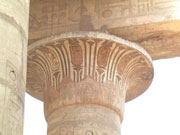TOUR NEWS - AMARNA EGYPT NOVEMBER-DECEMBER 2007
The B.C. Archaeology Tour of Amarna Egypt in November-December 2007 was a great success with everyone enjoying our exploration of the remarkable sites connected with the Amarna Period. We had a relatively small group which consisted of only 7: Allan Stuckey, Anne Heart, Teresa Romanovsky, Sebastian Cobb and Brenda Wass. The group leader was Dr Michael Birrell and the Egyptian guide was Mohamed Aziz (otherwise known as Aziz).
We arrived into Cairo International Airport in the late evening and checked into the Victoria Hotel located in the downtown part of Cairo. The following morning was spent at Giza where we walked around the outside of the Great Pyramid of Khufu and saw the superb cedar boat of the king. We then visited the pyramid of Khafre and after entering the pyramid, wandered around the impressive Mortuary Temple near the sphinx. In the afternoon we headed to the Khan el-Khalili markets where we spent a few hours exploring the numerous hidden alleys with their many shops.
We started next morning at Saqqara where we went to see the Imhotep Museum, a new collection of artifacts from the site which have not been seen by the public before. Amongst the many treasures are the painted wooden ka-statues of the local tomb owners. We then saw the Third Dynasty Step Pyramid of Zoser, one of the great masterpieces of Egyptian architecture. We also visited the tombs of Nianch-khnum and Khnum-hotep, and the impressive mastabas of Mereruka and Kagemni. We also descended into the pyramid of King Tety to discover the Pyramid Texts of the King.
We next spent a day at the dramatic desert sites of Meidum and Dahshur - both Old Kingdom sites which preserve a stark and isolated feeling largely because they are off the main tourist track and are therefore blissfully clear of crowds. Amongst the great pleasures of visiting these sites is the experience of descending into the burial chambers of the main pyramids and crawling through the robber's tunnel into Mastaba 17 at Meideum.
The following morning we drove across the western desert from Cairo to the edge of the Fayyum Oasis. Here we saw the extensive ruins of the Roman Period town of Karanis with two stone temples, ruined houses and baths. Lunch was spent in a restaurant located at the edge of the Fayyum Lake. In the afternoon we stopped at the pyramid of Senwosret II at Lahun and then heading south via the desert road to Minya, our base for the next five days.
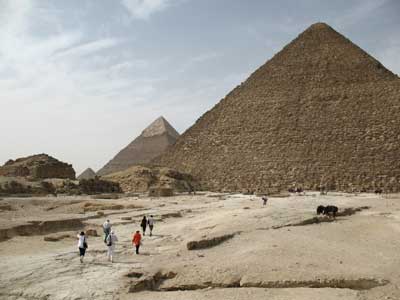 |
 |
Pyramids of Giza |
Lunch at the Fayyum Lake |
We had a morning of leisure in Minya, enjoying the most spectacular sun rise. Our hotel, the Aton Hotel, was located immediately on the edge of the Nile and it was always pleasant to spend time by the river watching the fishermen and birdlife. In the afternoon we travelled north by bus to see the ruins of the ancient city of Akhoris, now called Tehna el-Gebel. Here we saw the dramatic temple built by Nero, a rock-cut shrine dug into the face of a spectacular outcrop of rock. We also saw the ruins of the Roman city, and experienced a superb view over the agricultural zone.
The following day took us south of Minya to see a number of sites on the eastern bank. The first stop was Beni Hasan where we saw the beautiful painted tombs of the 11th and 12th Dynasty. The view across the Nile is always breathtaking from the terrace in front of the monuments. We had a picnic lunch in the local caf� at Beni Hasan before heading to see the desert temple of Queen Hatshepsut of the 18th Dynasty.
We next spent two days exploring the ancient city of Akhetaten, also called Amarna. We toured the superb painted North Tombs with their stunning view across the desert plain. We also saw one of the monumental Boundary Stelae, carved by Akhenaten to define the limits of his new city, and explored the ruins of the North and Riverside Palaces and the houses in the North City. One of the highlights of the visit is to experience the crossing of the Nile River on the local ferry with its colourful scene of village life including camels loaded with goods. On our second day at Amarna we descended into the Royal Tomb, built to house the remains of King Akhenaten and his immediate family. The tomb is carved in an isolated desert valley east of the city. We then explored the ruins of the ancient city including the temples to the Aten and the Royal Palace. The afternoon was spent in the South Tombs where we looked at the Hymn to the Aten in the tomb of Ay.
The next morning we travelled south of Minya to the town of Malawi where we stopped to see the local archaeological Museum. We then went to nearby Tuna el-Gebel where we exlored the painted Ptolemaic tombs, including the famous Greek tomb of Petosiris, as well as the atmospheric underground catacombs housing the mummified remains of the sacred ibises and baboons of Thoth. We had a pleasant picnic lunch at the site. In the afternoon we saw the ruins of the temple of Thoth at Ashmunein and the picturesque Christian cathedral of the 5th Century.
 |
 |
Sunrise over the Nile at Minya |
The Temple of Nero at Akhoris |
The following day we caught the First Class train to Luxor. The train left Minya mid-morning and arrived into Luxor in the late afternoon. The trip enabled us to sit back and watch the colour and bustle of the local landscape as we headed south. Time was spent reading, listening to music and chatting. The following morning we visited Luxor Temple, located in the heart of the modern city. We explored this beautiful monument thoroughly, concentrating on the remains of the Amarna Period in particular. These included the impressive Opet Festival scenes of Tutankhamun and the religious scenes of Amenhotep III. We had lunch in a caf� and then took a felucca sail boat ride on the Nile. A spectacular sunset was our reward! In the evening we saw the impressive Luxor Museum with its famous talatat relief scenes from Akhenaten's demolished Aten temple at Karnak.
Next day we walked the desert path across the Theban Hills from Deir el-Medina to Deir el-Bahri, stopping along the way to look down into the Valley of the Kings. Our walk took us along the edge of the great precipice that rises behind the temple of Queen Hatshepsut and certain members of the group were keen to keep as far away from the edge as possible! The view however was worth the effort, especially looking over the green fields towards the Nile. We descended from the Theban Hills to spend the rest of the morning at the famous mortuary temple of Queen Hatshepsut of the 18th Dynasty. We had lunch on the West Bank before travelling by bus to the Valley of the Kings. Here we saw a number of royal tombs including the tomb of Tutankhamun in the main Valley and the tomb of King Ay in the West Valley.
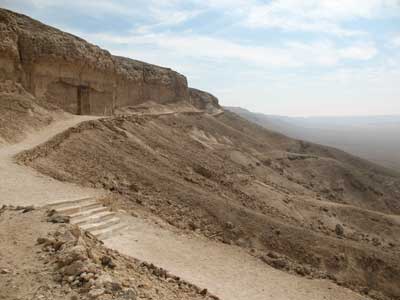 |
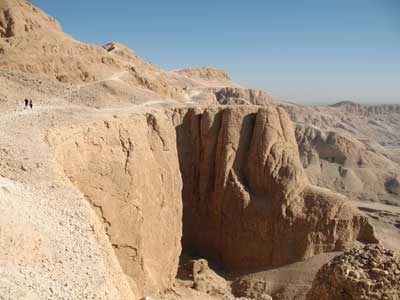 |
The North Tombs at Amarna |
The walk over the Theban Hills |
We then spent a day exploring the extensive ruins of Karnak Temple with a special emphasis on the Amarna Period. The new paved forecourt in front of the temple is impressive but somehow bleak and impersonal - it's a shame that the local restaurants were demolished as well. We saw the Hypostyle Hall, the Third Pylon, and the 18th Dynasty Festival Hall of Tuthmosis III. The following day was spent on the West Bank of the Nile at Luxor. We started at the Colossi of Memnon, the two monumental seated statues of King Amenhotep III. From here we went to Deir el-Medina where we saw the remains of the Workers Village and explored two wonderful painted tombs. Lunch was in a nearby caf� - in the afternoon we toured three painted tombs of the 18th Dynasty.
The following day was set aside for rest and relaxation. The author enjoyed a felucca ride in the afternoon. The evening was spent at the hotel where we enjoyed a wonderful buffet dinner and entertainment by village musicians and dancers. We saw a 'sufi' whirling dancer, but the highlight of the evening was definitely Teresa's belly dancing performance which far surpassed the local talent - well done Teresa!
 |
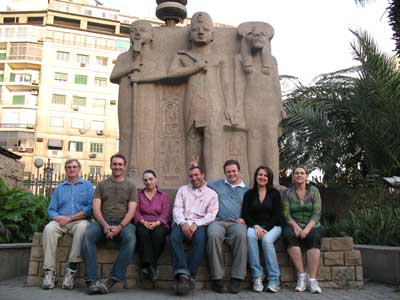 |
The sacred Lake at Karnak |
The Nov 2007 group at the Cairo Museum |
We flew to Cairo next morning. We explored part of the Old City of Cairo and saw awe inspiring buildings of the Islamic Period - including the Mohamed Ali mosque and the monumental Mosque of Sultan Hassan. The day ended with shopping in the Khan el-Khalili markets. The next day was spent in the Cairo Museum with a guided tour focussing on the 18th Dynasty remains. We saw the statues and reliefs of the Amarna period, the treasures of Tutankhamun and the burial equipment of Yuya and Tjuya, parents of Queen Tiye. There was also free time for exploring other parts of the museum's remarkable collection. A wonderful tour and great fun!
Michael Birrell
